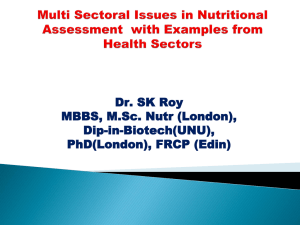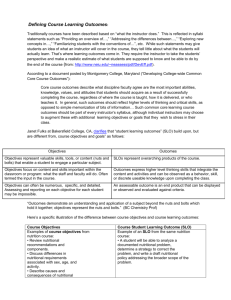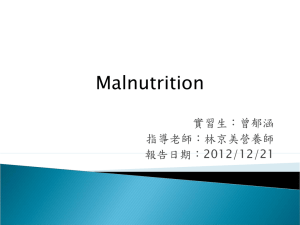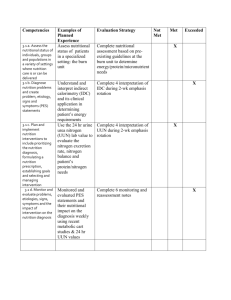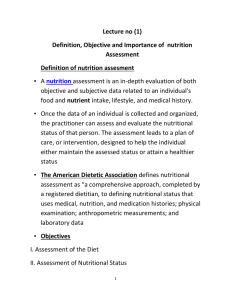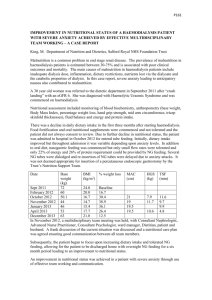Chapter 3
advertisement
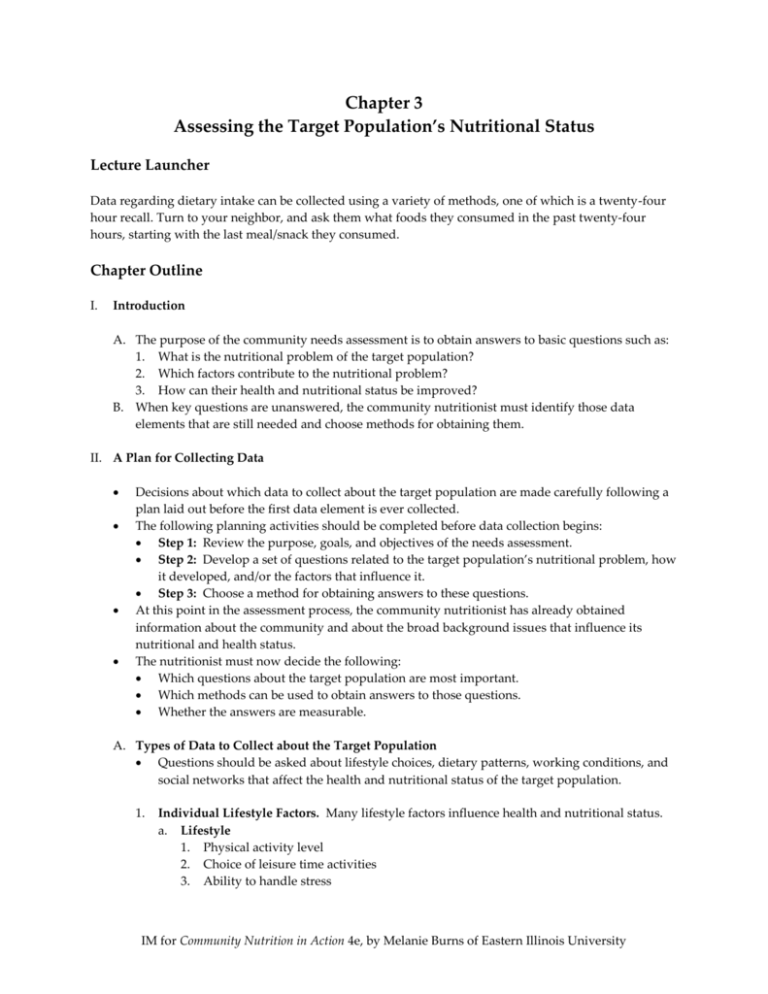
Chapter 3 Assessing the Target Population’s Nutritional Status Lecture Launcher Data regarding dietary intake can be collected using a variety of methods, one of which is a twenty-four hour recall. Turn to your neighbor, and ask them what foods they consumed in the past twenty-four hours, starting with the last meal/snack they consumed. Chapter Outline I. Introduction A. The purpose of the community needs assessment is to obtain answers to basic questions such as: 1. What is the nutritional problem of the target population? 2. Which factors contribute to the nutritional problem? 3. How can their health and nutritional status be improved? B. When key questions are unanswered, the community nutritionist must identify those data elements that are still needed and choose methods for obtaining them. II. A Plan for Collecting Data Decisions about which data to collect about the target population are made carefully following a plan laid out before the first data element is ever collected. The following planning activities should be completed before data collection begins: Step 1: Review the purpose, goals, and objectives of the needs assessment. Step 2: Develop a set of questions related to the target population’s nutritional problem, how it developed, and/or the factors that influence it. Step 3: Choose a method for obtaining answers to these questions. At this point in the assessment process, the community nutritionist has already obtained information about the community and about the broad background issues that influence its nutritional and health status. The nutritionist must now decide the following: Which questions about the target population are most important. Which methods can be used to obtain answers to those questions. Whether the answers are measurable. A. Types of Data to Collect about the Target Population Questions should be asked about lifestyle choices, dietary patterns, working conditions, and social networks that affect the health and nutritional status of the target population. 1. Individual Lifestyle Factors. Many lifestyle factors influence health and nutritional status. a. Lifestyle 1. Physical activity level 2. Choice of leisure time activities 3. Ability to handle stress IM for Community Nutrition in Action 4e, by Melanie Burns of Eastern Illinois University b. 2. 4. Smoking status 5. Use of alcohol or drugs Diet. Diet is a key individual factor to be analyzed because nutritional status is affected directly by nutrient intake and utilization and indirectly by the food supply and a host of other factors. 1. The food supply determines which foods are available to the target population and this is a product of: a. Geographical area b. Climate c. Soil conditions d. Labor e. Capital available for building the agricultural base 2. Food intake is influenced by many factors, including the following: a. Biological, psychosocial, cultural, and lifestyle factors. b. Personal food preferences, cognitions, and attitudes. c. Health beliefs and practices. 3. Nutrient utilization is affected by: a. Activity levels. b. Smoking status. c. Dietary supplement use. d. Drug-nutrient interactions. e. Physiological status. Living, Working, and Social Conditions. The manner in which the target population lives and works affects their health and nutritional status. a. Education, occupations, and income all have powerful effects on health. b. Individuals who have few or no job skills or who are poor and uneducated tend to have more health problems than those with job training and education. c. Low socioeconomic status is linked with: 1. High prevalence rates of chronic conditions. 2. High stress levels. 3. Reduced access to medical care for the diagnosis and treatment of diseases. 4. Poor outcomes following treatment. d. Poverty, even more than family structure, has the strongest association with health among children. e. Primary social groups also influence health and nutritional status. f. The family exerts the most influence on health and nutritional status. III. Case Study 1: Women and Coronary Heart Disease The community nutritionist reviews the assessment’s objectives and determines a list of questions about this population’s knowledge, attitudes, and practices related to Cardiovascular Heart Disease (CHD). Demographic data, such as age, education level, and income are collected as a matter of course. Answers to questions are obtained from individuals who represent the target population, which is called the sample. Next, the nutritionist would consider the types of data that might be collected to answer the questions and chooses a method for obtaining them. IM for Community Nutrition in Action 4e, by Melanie Burns of Eastern Illinois University A survey instrument is used to obtain answers to several of the questions and a 24-hour recall method is used as a separate tool. A. Methods of Obtaining Data about the Target Population A variety of methods exist for collecting data related to the target population. 1. Survey. A survey is a systematic study of a cross-section of individuals who represent the target population. It is a relatively inexpensive method of collecting information from a large group of people. Surveys can be used to collect qualitative or quantitative data in formal structured interviews and they can be used by phone, mail, or online. They can be used with individuals and groups and they can be either self-administered or administered by a trained interviewer. Survey design and analysis is a discipline in itself. The first step is to determine the purpose of the survey. Most nutrition surveys are carried out to: Assess the food consumption of households or individuals. Evaluate eating patterns. Estimate the adequacy of the food supply. Assess the nutritional quality of the food supply. Measure the nutrient intake of a certain population group. Study the relationship of diet and nutritional status to health. Determine the effectiveness of an education program. Decisions must be made about who will design the survey, who will conduct it, and how it will be carried out. Surveys must be designed and carried out carefully to provide valid and reliable information. a. 2. Health Risk Appraisal. The health risk appraisal (HRA) is a type of survey instrument used to characterize a population’s general health status. 1. It is used in different settings as a health education or screening tool. 2. The HRA consists of three parts: a. A questionnaire. b. Certain calculations that predict risk of disease. c. An educational message or report to the participant. 3. HRAs are used to alert people about their risky health behaviors and how such behaviors might be modified through a lifestyle modification program. Screening. Screening is an important preventive health activity designed to reverse, retard, or halt the progress of a disease by detecting it as soon as possible. a. Screening can be conducted in clinical and community settings and examples include: 1. Blood pressure checks. 2. Blood cholesterol checks. 3. Height and weight. b. Screening programs are not meant to substitute for a health care visit but they do have educational value and serve to identify high-risk persons. IM for Community Nutrition in Action 4e, by Melanie Burns of Eastern Illinois University 3. Focus Groups. Focus groups are informal groups of about 5 to 12 people who are asked to share their concerns, experiences, beliefs, opinions, or problems. a. Focus groups can be used to: 1. Obtain advice and insights about new products and services. 2. Research data and information about key variables used in quantitative studies. 3. Obtain opinions about products or creative concepts such as advertising campaigns or program logos. b. Focus groups are led by a trained moderator and listening is the most important skill used during focus groups. c. Information from a focus group is used to provide direction for the needs assessment or change a marketing strategy, product, or existing program. d. Focus groups provide qualitative information that helps nutritionists understand how the nutritional problem developed and whether the target population perceives a problem. 4. Interviews with Key Informants. Interviews with key informants, or people in the know about the community, can also provide information about the target population. a. Informant interviews can be used to: 1. Complete a cultural assessment of the target population. 2. Provide insights about whether the target population perceives a nutritional problem and which actions for addressing the problem are culturally appropriate. b. Key informants may have worked with the target population in the community or conducted research on the population. 5. Direct Assessment of Nutritional Status: An Overview of Methods. There are several methods for conducting a direct assessment of nutritional status. Dietary assessment methods are used to determine an individual’s or population’s usual dietary intake and to identify potential dietary inadequacies. The primary methods of measuring food consumption of individuals include: a. b. c. d. Diet History Method Twenty-four-Hour Recall Method Diet Record Method Food Frequency Method Additional methods of assessing nutritional status include: e. f. Other Diet Assessment Methods Laboratory Methods. Laboratory methods can be used to identify individuals at risk of a nutrient deficiency and to detect subclinical deficiencies. g. Anthropometric Methods. Measurements of the body’s physical dimensions and composition, called anthropometric methods, are used to detect degrees of malnutrition and chronic imbalances in energy and protein status. The most common growth indices include measures of stature (height and length), weight, and circumference of the head. h. Clinical Methods. Clinical methods consist of a medical history and physical examination to detect physical signs and symptoms associated with malnutrition. 1. The history includes a description of factors such as living situation, existing clinical conditions, smoking status, medications, and usual level of physical activity. IM for Community Nutrition in Action 4e, by Melanie Burns of Eastern Illinois University 2. In the physical exam the clinician evaluates the major organ systems and examines the hair, face, eyes, lips, tongue, teeth and gums, and nails for signs of malnutrition. IV. Issues in Data Collection A. Practical Issues. The choice of assessment method is influenced by several issues including: 1. The number of staff available to collect and analyze the data. 2. The cost of administering the test. 3. The amount of time needed to identify and interview or sample members of the target population. 4. The assessment method chosen should be simple to administer, take only a few minutes to complete, be inexpensive, and be safe. B. Scientific Issues. Scientific issues such as validity, reliability, and sensitivity of the assessment method and the nature of dietary variation also influence the choice of assessment method. 1. Sensitivity versus Specificity a. Sensitivity is defined as the proportion of subjects with the disease or condition who have a positive test for the disease or condition. 1 A sensitive test rarely misses people with the disease or condition. 2. It is often used in screening situations in which the purpose of the test is to detect a disease or condition in people who appear to be asymptomatic. b. Specificity is defined as the proportion of subjects without the disease or condition who have a negative test. 1. Specific tests are used to confirm a diagnosis. 2. The oral glucose tolerance test is a highly specific test for diagnosing diabetes mellitus. c. Ideally, the assessment method should be both highly sensitive and highly specific. 2. Validity and Reliability. Other considerations for evaluating assessment methods include the instrument’s validity and reliability. a. Validity refers to the ability of the instrument to measure what it is intended to measure. 1. Another word for validity is accuracy. 2. An instrument’s validity can be affected by many factors including the characteristics of the respondent, the questionnaire design, the adequacy of reference data, and the accuracy of data input and management. b. Reliability is the ability of an assessment instrument to produce the same estimate of dietary intake, for example, on two separate occasions. 1. Other terms for reliability are precision, repeatability, and reproducibility. 2. It is different from validity and it is possible for an instrument to give reproducible results that are incorrect. C. Cultural Issues. A cultural assessment of the target population is needed before data collection begins. 1. A cultural assessment is undertaken to identify appropriate and inappropriate behaviors within the target population’s culture. 2. The manner in which people greet each other, the types of questions that are appropriate to ask, body language, and customs differ among cultures. 3. Survey questions must also be culturally appropriate. IM for Community Nutrition in Action 4e, by Melanie Burns of Eastern Illinois University V. Case Study 2: Nutritional Status of Independent Elderly Persons Before collecting data about the target population, the nutritionist reviews the purpose, goals, and objectives of the assessment and then develops a set of questions aimed at measuring the nutritional status of this target group. The nutritionist might consider a standard measure of health or nutritional status which is called a nutrition status indicator. A nutrition status indicator is a quantitative measure used as a guide to screen, diagnose, and evaluate interventions in individuals. Nutrition status indicators are often used to: Estimate the magnitude of a nutrition problem. Its distribution within the population. Its cause. The effects of the programs and policies designed to alleviate the problem. Several indicators, such as these, might be used in the nutritional status of the elderly. A weight loss of 5 percent or more of body weight in 1 month. Being underweight or overweight. Having a serum albumin below 3.5 grams per deciliter. A. Putting It All Together 1. 2. 3. 4. 5. This phase of the community needs assessment focuses on obtaining data about the target population. It is designed to find answers to questions about how extensive the nutritional problem is and how it developed. Once the data are analyzed the nutritionist must choose reference data against which the assessment’s outcomes can be compared. a. Nutrient intake data are usually compared with the Dietary Reference Intakes (DRIs). b. Other data might be compared with standards derived by the U.S. National Center for Health Statistics or the NHANES survey. Statements drawn from the data collected about the target population and from comparisons with reference data are then organized and added to the final report. The final report contains information about the target population and about the community in which it lives and works. IM for Community Nutrition in Action 4e, by Melanie Burns of Eastern Illinois University

